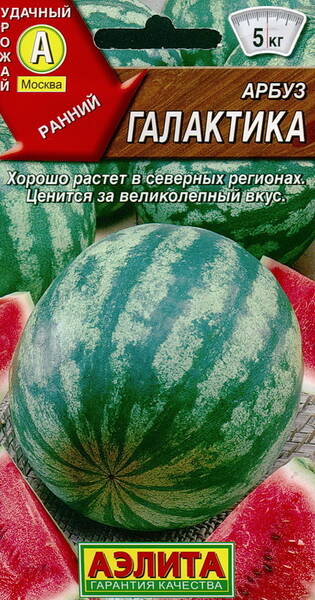A popular cultivar from an early variety group "Crimson Sweet". The first fruits ripen approximately 70-75 days from germination. The plants are medium-climbing, with well-developed leaf apparatus. They bear fruit stably not only in the south, but also in northern conditions (under film). The fruits are round, with an average weight of 3-5 kg (in the south, the weight of the berries can reach 12 kg). The rich red, juicy flesh has a fine-grained, sugary structure. The taste is great. The fruits retain commercial quality for 20 days after collection.
Agricultural technology.
Watermelon is grown in open ground and greenhouses, on light air- and water-permeable soils. Sowing approximately in May, when the soil warms up to a depth of 8-10 cm to +15°C. Planting pattern 140x100 cm. In greenhouses - 70x70 cm, using trellises (fruits can be hung in nets).
Before sowing, the seeds are treated in a solution of potassium permanganate, then washed with clean water. The seedling method of cultivation is also used. In this case, the seedlings are planted after the last frost at the age of 3-4 true leaves. As they grow, the plants form into one stem, removing side shoots and leaving 2-3 ovaries on it (the rest are removed) and pinch off the growing point.
Further care consists of moderate watering, loosening, fertilizing and sprinkling of vines to protect them from being overturned by the wind.
* Perhaps there is hardly a person who will say that he does not like watermelons!
Everyone liked this giant berry. During the harvest season, many even use a watermelon diet to cleanse the kidneys and urinary tract, which is really effective.
But few people know that this fruit also has other healing properties:
For example, watermelon is rich in iron, hence helps in anemia.
The increased content of easily digestible sugars makes it useful for diabetes.
For the treatment of liver and gall bladder diseases, including cirrhosis, Botkin's disease, atherosclerosis, hypertension, gout, gastritis, constipation, arrhythmia, coronary insufficiency, sore throat, obesity and various intoxications, it is recommended to include 2-2.5 kg of fresh watermelon in the daily diet pulp.
For general cleansing of the body (in the absence of contraindications), watermelon fasting is used, when only watermelons and rye bread are eaten for 3-4 days - intense urine production during these days flushes the kidneys and urinary tract, removing grains of sand and small stones.
In watermelon, not only the pulp is healing, but also the rind itself with seeds, which can be prepared for future use and used for the same diseases as the pulp (in the form of decoctions and infusions).
So, for gastritis, 100 g of dry crusts should be poured into 0.5 liters of boiling water and left until completely cooled. It is better to do this in a thermos (adults with an average weight of 70-75 kg are recommended to take 100-125 ml of infusion 4-6 times a day, and reduce the children’s dosage in proportion to the child’s weight).
For cholelithiasis and to cleanse the bile ducts, pour 150-170 g of dry crusts with a liter of boiling water, put on low heat and boil for 25-30 minutes. Take 200 ml of the decoction before meals 3-5 times a day.
Consumption of watermelon pulp in large quantities is contraindicated in case of renal failure, exacerbation of stomach and duodenal ulcers.












